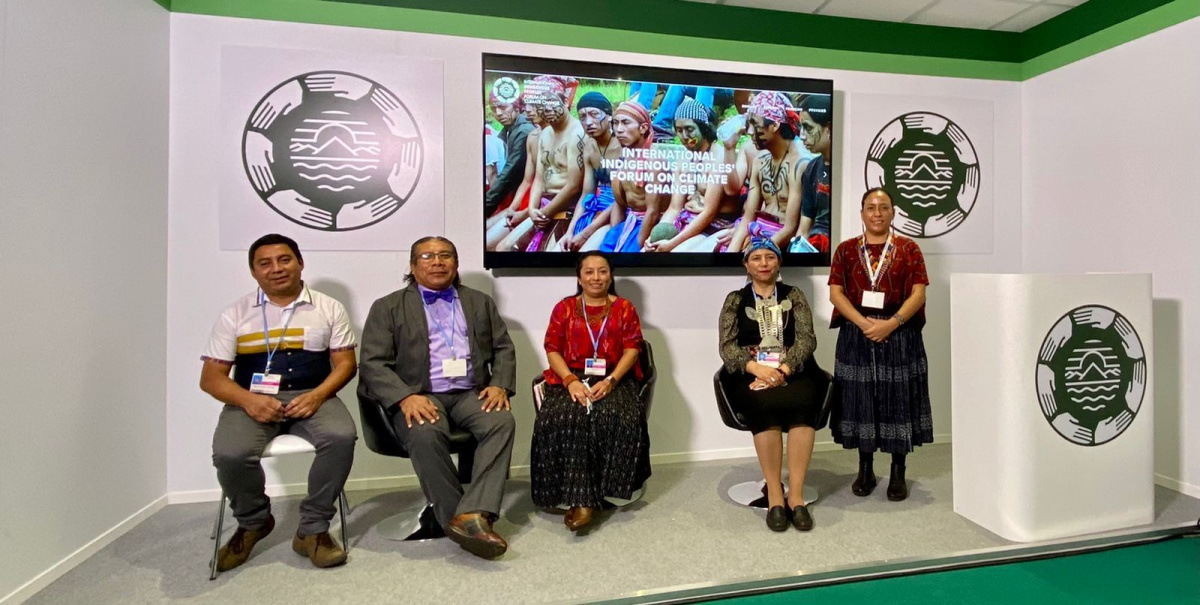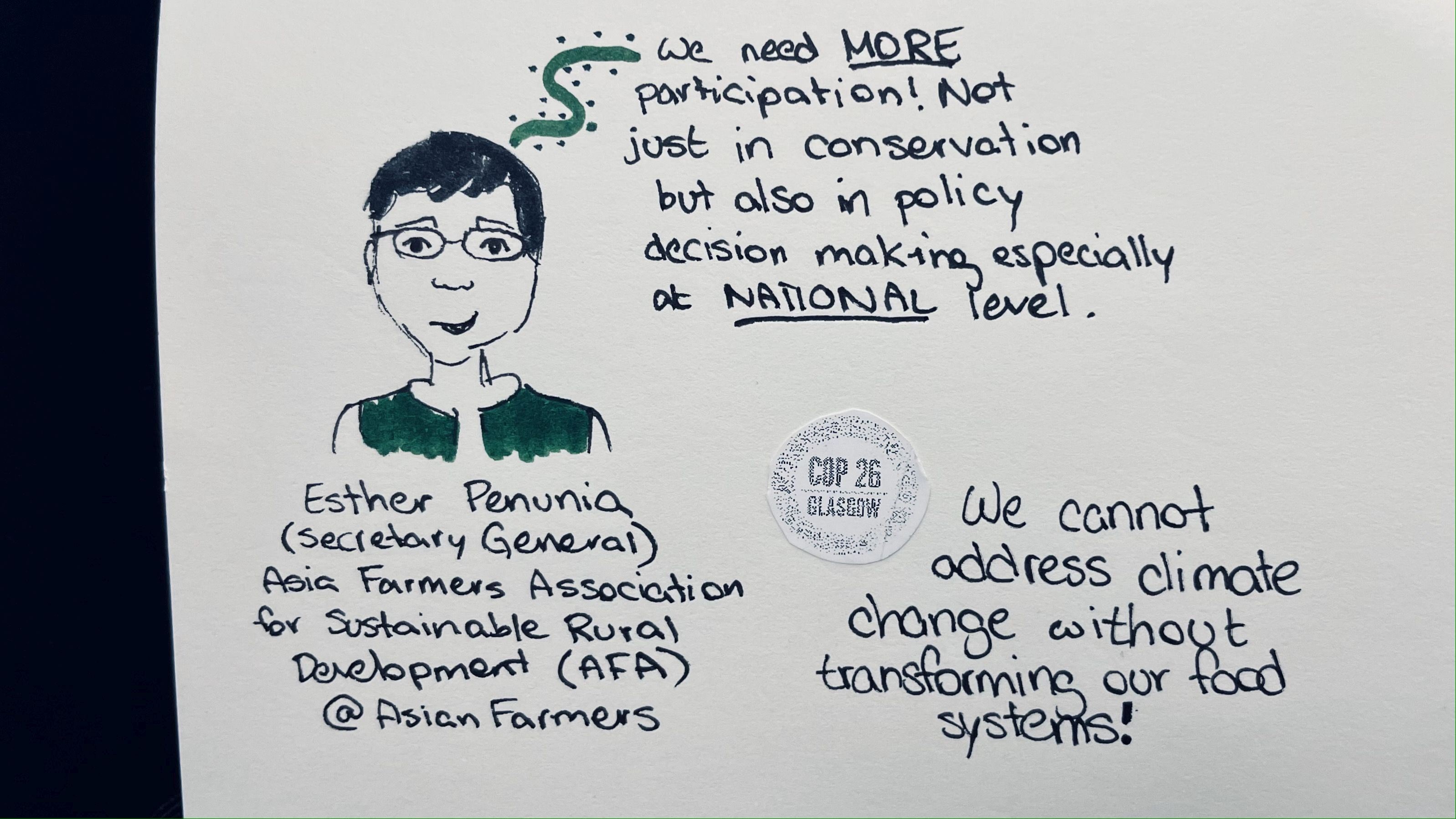They work the land. They protect the land. Does COP26 notice?
Indigenous peoples and local communities are included in the final version of the 26th session of the UN Climate Change Conference of Parties (COP26)’s decision text, a definite success compared to previous years. Direct financing for these groups has also been celebrated as a key success at COP26. However, how much progress was actually made, and which groups were kept on the side-lines? Many challenges still remain, and there is more to be done to include farmers’ voices in key discussions and decision-making.

Photo: IUCN
At this year’s COP26 in Glasgow, indigenous peoples and local communities (IPLCs) were publicly recognised as the best placed to preserve forests and biodiversity. Indeed, financial support for climate adaptation and mitigation solutions involving these groups has seen a huge increase, with $1.7 billion pledged to IPLCs in support of securing land rights. This commitment was made by governments (United Kingdom, Norway, the Netherlands, the United States and Germany) with the contribution of philanthropist foundations, such as the Ford Foundation and the Bezos Earth Fund.
Where will the funds end up?
Throughout COP26, there were significant commitments made to support local solutions to a just transition in Africa, Asia, and Latin America. IPLCs were also hailed in the Glasgow Declaration on Forests and Land Use, which pledged to end or reduce deforestation by 2030, and has been signed by over 140 countries at time of writing, representing over 90% of the world’s land. These commitments are situated within the larger context of an increasing body of research recognising the critical role of IPLCs in effective climate adaptation and mitigation strategies. A WRI report recently stated that IPLCs are the most effective groups in safeguarding land, and that although they make up 5% of the population, they guard 80% of land and have been allocated less than 1% of official development assistance for climate change. While these ensuing commitments are hugely encouraging and reflect an increased recognition of the value of groups that have historically been excluded from such funding, how much will change on the ground?
We are pleased with the announcement of the funding, but will wait for concrete measures to reveal whether the intent is to transform a system that has directed less than 1% of climate funding to indigenous and local communities. What matters is what happens next," says Tuntiak Katan, an indigenous leader of the Shuar people of Ecuador and General Coordinator of the Global Alliance for Territorial Communities (GATC).
The hope is that this funding trickles down to those who are the best placed to implement effective measures; the inclusion of local actors is fundamental to a just transition to a low carbon economy. In the meantime, those fighting for the environment and land rights continue to face persecution, violence, and death as a direct consequence of their activism. In 2020, a record number of those campaigning for the environment and land rights were killed, and over a third of these were indigenous people. Indigenous women and girls are also far more likely to be targeted for violence than other groups.
Voices of farmers yet to be heard
Despite this progress, there was a large gap in the inclusion of the world’s largest private sector: smallholder farmers. There was no reference to the role of the world’s farmers in the COP26 final document, and their presence and voices were overall less visible, loud, or organized. While regenerative agriculture and sustainable food systems was a topic of conversation, there are significant improvements to be made to include the voices and presence of smallholders. They produce around one third of the world’s food, yet are the most undernourished segment of society.
We give you the food to live well, but often can’t live well ourselves; our livelihoods are at the mercy of next season’s yield. Too many of us go hungry every day. The suicide rate in farming is higher than any other sector. And it’s rising," said Elizabeth Nsimadala, President of the Eastern Africa Farmers Federation (EAFF), Director in charge of women’s affairs and immediate past president at the Pan-African Farmers Organisation (PAFO), at the launch of the Regenerative Agriculture in Africa report.
Difficulties in unifying voices of farmers may lie in variation in size, opinions, goals, and challenges faced by farmers around the globe. So how can a unified farmer’s voice be strengthened across climate negotiations, without erasing the underlying diversity within this group?
One of the greatest failures of development policy and practice is the treatment of smallholders as a homogenous group. This lack of differentiation and segregation leads to the lowest common denominator and one-size-fits-all approaches, resulting in limited impact and frustrations on both ends. It really has to be horses for courses," says Ishmael Sunga, Chief Executive Officer of the Southern African Confederation of Agricultural Unions (SACAU).
It is important for this perspective to be considered from a gender lens as well; women farmers receive only 10% of financial assistance provided for agriculture, forestry, and fishing, despite being responsible for 60-80% of food production in developing countries.
Facing challenges
While IPLCs face issues with regards to land rights, smallholder farmers are also affected by land tenure issues, among other challenges. In certain countries, land tenure issues can prevent farmers from implementing restoration measures, due to the cost and the uncertainty of tenure over their land. Yet, if any solutions are to be implemented, these groups must be at the centre of decisions.
Smallholder farmers are feeding Ghana, and have the traditional knowledge needed for restoration," said Hajia Alima Sagito, Vice President of the Ghana Federation of Forest and Farmer Producers and Executive Director of the Savanna Women Integrated Agency.
 Photo: IUCN
Photo: IUCN
 Photo: IUCN
Photo: IUCN
Nature-based Solutions are key
Sagito advocated for Nature-based Solutions (NbS) in tackling the challenges faced by smallholder farmers, an approach discussed throughout many side events in Glasgow. NbS have become more widely recognized and endorsed by governments, businesses, some indigenous peoples groups, and other actors, as a legitimate approach. Indeed, references to NbS were made in the first draft of the COP26 text, despite not making it into the final version. As this approach becomes more widely adopted, it is crucial that the essence of Nature-based Solutions as being measurable and inclusive, is preserved. Nature-based Solutions are defined as ‘actions to protect, sustainably manage and restore natural or modified ecosystems, that address societal challenges (e.g. climate change, food and water security or natural disasters) effectively and adaptively, simultaneously providing human well-being and biodiversity benefits’. It is also crucial to keep in mind that solutions must not only be nature positive: "to be sustainable they necessarily and ultimately have to be income positive- otherwise they remain a pipe dream!," says Sunga.
Some encouraging steps in pre-COP and COP
Nevertheless, there have been some positive steps made with regards to smallholder farmers and other groups during COP26. On 2 November, the UK’s Foreign, Commonwealth & Development Office (FCDO), announced new funding totalling £143.5 million to support African-led projects in the realm of climate change adaptation, including £42 million for the Africa Regional Climate and Nature Programme and £6.5 million for the Forest and Farm Facility (FFF). The FFF is a partnership between the Food and Agriculture Organization, the International Institute for Environment and Development, the International Union for Conservation of Nature and AgriCord, which provides direct technical and financial support to forest and farm producer organizations, including smallholders, rural women’s groups, local communities and indigenous peoples’ organizations.
The FFF’s contributions in the lead up to and throughout COP26 included playing a part in mobilizing finance for the $1.7 billion pledged to IPLCs, generating media coverage on IPLC issues, and highlighting challenges and solutions held by smallholder farmers’ and IPLCs at COP26 through several side events. Although these may not yet have been reflected in the official negotiation, this work is important in building momentum towards COP27, a central theme of which will be agriculture. Of the farmer representatives present at COP26, calls for support to scale up solutions already being implemented by smallholder farmers were strong:
We understand how to farm in a way that respects nature, and that nurtures land as a carbon sink. We’ve been doing it for years but we need your help to do this at scale. We stand ready to play our part in fighting climate change, reversing nature loss, and providing affordable healthy food for all. But we need you to act with us. And there is no time to waste," said Elizabeth Nsimadala.
In all, COP26 saw some positive moments for IPLCs, but funding commitments still need to be operationalized. The outcome of the pledges made in Glasgow can only be truly judged once they are put into action, the success of which will largely be determined by the extent these funds reach local actors on the ground. It is crucial for the voices of smallholder farmers to be heard within the context of these decisions, and for local actors to be engaged throughout the process. Adequate and direct financing, along with meaningful engagement of diverse groups and increased representation, especially in decision-making and leadership roles, constitute the building blocks to an inclusive future.
—Web story by Zoe Williamson (IUCN) and the FFF
Links to specific events at UNFCCC COP26
 Photo: IUCN
Photo: IUCN
Data for Forest and Farming, 5 November https://www.youtube.com/watch?v=q8o9whww8ZQ
Forest Community Land Rights for Nature, Climate and People, 6 November https://youtu.be/jShq0pbtuAM



